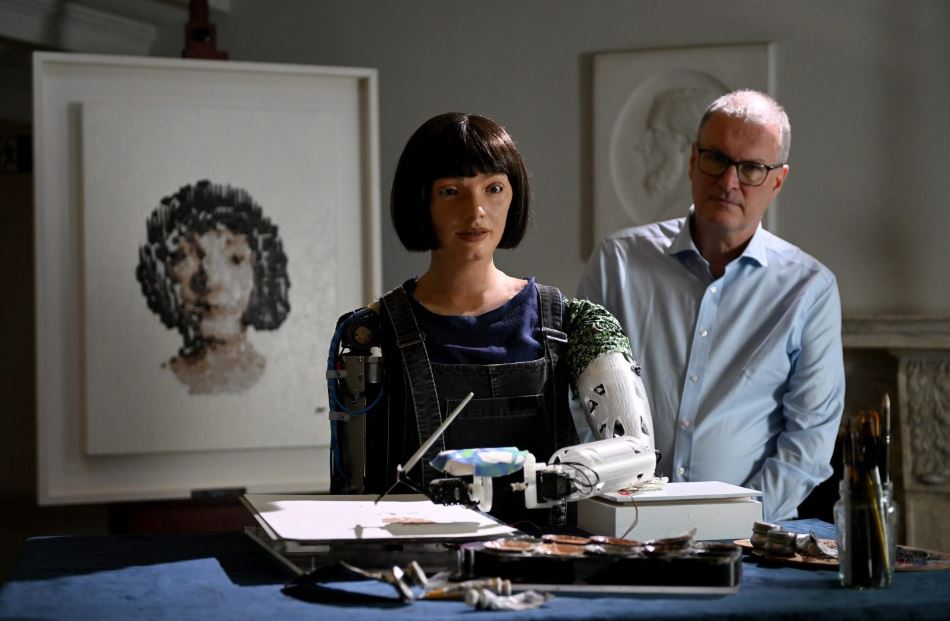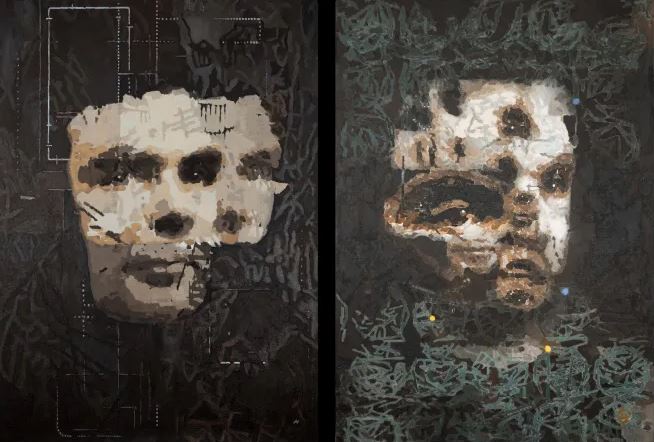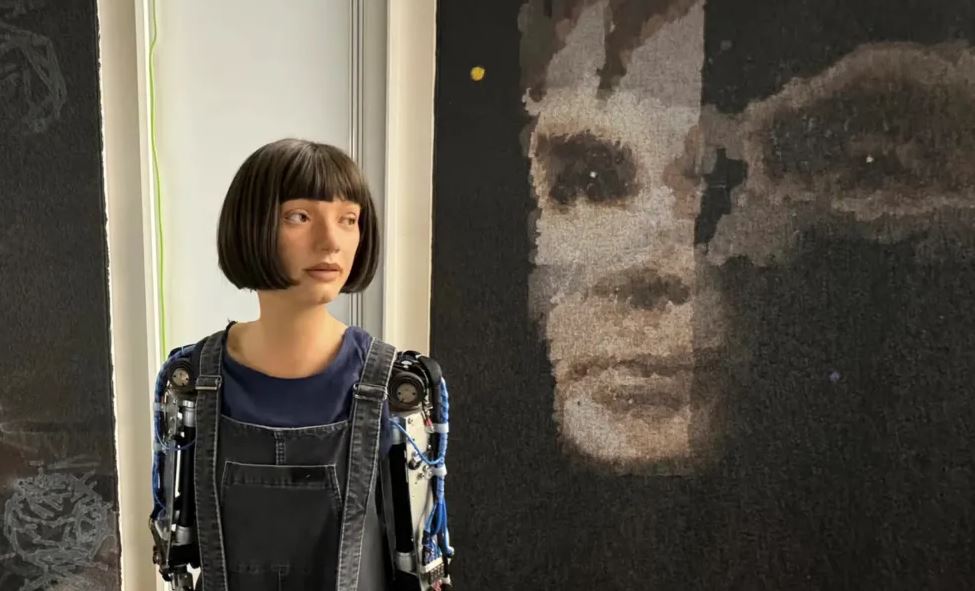The artistic capabilities of AI were recently given a closer look by a humanoid AI robot named Ai-Da who recently sold artwork for 1.08 million dollars which made record sales for AI-art. This astonishing sale proves that AI has already entered the sphere of art and has accelerated discussions about the nature of art in the future. General, Ai-Da’s accomplishment is creating discussions on the scope of AI art, and its possibility of reshaping art. But here we’ll give you a closer look at this peculiar event, the interesting story of AI robot painting, and its potential implications for art and technology.
A Unique AI Robot Artist
Ai-Da formulated by British art dealer Aidan Meller in 2019 as an art robot producing technically innovative and philosophically stimulating AI robot art paintings. Ai-Da is an interesting new concept as an ultra-realistic AI artist created from principles of machine learning and emerging fields of robotics and aesthetic engineering. Due to the highly advanced programming, Ai-Da has composed a portfolio of artworks that redefine art and creativity. British scientist Alan Turing, a computing and AI pioneer, inspired the AI robot painting that captured international attention. By designing a tribute in the form of an AI robot painting, Ai-Da connects technological creativity with historical homage, sparking fresh perspectives on machine creativity.
A Tribute to Alan Turing in an AI Robot Painting
The AI robot painting that sold for an incredible $1.08 million was titled “AI God: Portrait of Alan Turing.” This is a commemorative of Turing, the code breaker and the computing pioneer who once posed the question, “Can a machine think?” Ai-Da produced the AI robot painting by analyzing a photograph of Turing and then converting it into an artistic piece. Ai-Da painted every single stroke with her robotic arm and the portrait of Turing represents art infusion with technology.
This idea of this AI robot painting emerged from the conversation on ‘AI for good’ where Ai-Da chose the style, color, and texture of the painting in one of her paintings by herself. The AI robot-generated painting has generated debates on the ability of art created by technology and pays tribute to Turing in a revolutionary manner.
Auction Success of the AI Robot Painting
This Turing portrait is called “AI God” and sold at Sotheby’s for $1.08 million, far in excess of its initial estimate of $180,000. As can seen from such a record, the market interest in AI art continues to rise, and artificial intelligence robot paintings are now becoming seen as highly desirable objects that possess value. Sotheby characterized AI robot painting as an enriching experiment of human and mechanical symbiosis by saluting Turing’s concept of mechanical thinking.

This success has spurred a continuing discussion in society regarding the capability of AI-produced artwork to be as meaningful or valuable as artistic work made by human beings. As this study shows that the new generation of AI Robots captures a portrait of Turing in a rather creative way, this painting of Ai-da proves that the audience has embraced the practice of AI Robot painting as a meaningful piece in the art world.
Artistic Challenges Posed by AI Robot Paintings
The successful attempt performed by Ai-Da’s AI robot to paint a portrait obliges one to ask certain ethical and creative interrogatives. First of all, who the author of a piece created by an AI? Who owns the robot is it the robot itself, the indomitable coders, or the institution that is funding the project? The classical artist refused the premise of Big Bang, AI robot paintings. Stating that there is no feeling or experience which will be in the painting. Another criticism of art generated by an AI robot painting is that art created by hands cannot move people. As the art created by AI, while other critics believe that art generated by an AI robot painting is a widening range of art.
Joining these concerns, AI robot paintings provide new form of machine-created art experiences. And concepts for the contemporary art world which influenced by new technologies. Ai-Da’s work demonstrates that AI in art is opening the door to being a source. And a tool to transform a creative piece.
The Future of AI Robot Paintings in the Art World
As AI technology evolves, it predicted that AI robot paintings progress and firmly stake their claim in the art. AI may become an artistic collaborator, supplementing the artists’ ‘gut’ feelings with robotics to take aesthetic directions they wouldn’t normally be able to take. The examples of AI robot paintings shown in this paper have conclusively demonstrated. That creativity is redefined by technology to create art that is useful, attractive, and meaningful to buyers.
There are strong expectations that the trend displayed by AI and similar AI creations will only evolve. And can significantly shape the future creation process. The continuous contribution of AI robot paintings exhibits that art has started accepting such innovations. Ai-Da’s works suggest a future where AI robot paintings become familiar features in galleries and homes. And commercial spaces, evolving the landscape of art appreciation.
AI Robot Paintings Beyond Art Galleries
Beyond auctions and gallery displays, AI robot paintings have practical applications in other fields. Such as marketing, digital design, and film production. As demand for AI-generated designs rises, AI robot paintings offer visually captivating solutions. Adding fresh, scalable visuals to ad campaigns and media. Ai-Da’s AI robot painting of Turing may have been a breakthrough in the auction world. But it also signifies the growing role of AI art in a wide range of industries.

From advertisements to virtual artwork, AI robot paintings may soon become integral parts of our daily lives. Ai-Da’s production is evidence that Irina goes against the idea of AI art and technology. As revolutionary only in business and that AI innovation is limitless.
Conclusion
Ai-Da’s breakthrough AI robot painting of Alan Turing reflects a new stage in the art industry. Artificial intelligence is changing the art system and painting. This sale not only highlights the public interest in AI-generated art. But also fuels ongoing discussions about AI’s role in cultural and artistic realms. With the rise of the AI art era, robot art like Ai-Da can further link the gap between science and art. To create new possibilities for artists of the future and art buyers.
FAQs
Ai-Da’s AI robot art is a representation of what Alan Turing has donated to AI.
The AI robot painting was according to trend sold at the Sotheby’s auction with a mind-blowing $1.08 million.
Ai-Da is an art robot, a humanoid artist who is programmed to produce art paintings by an AI robot.
Turing’s work in AI and computing made him an ideal subject for an AI robot painting.
